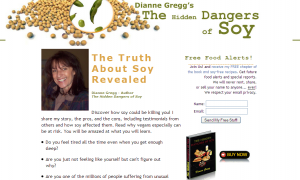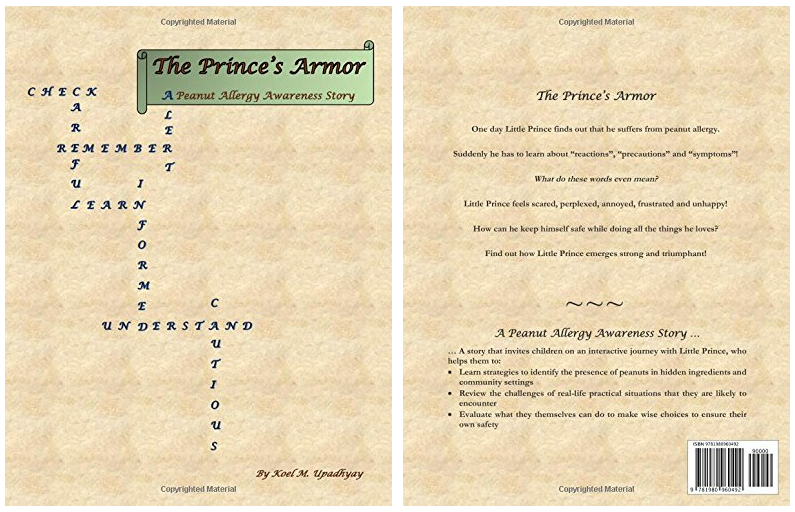
In Dianne Gregg’s book “The Hidden Dangers of Soy“, Ms Gregg’s discusses the many potential health issues related to soy consumption.
Following is a Q&A provided by Ms Gregg:
What inspired you to write this book?
For eight years I complained to doctors that I was always nauseous, bloated, and gaining weight. The physicians I consulted said weight gain was normal at my age and not to compare myself to 30 year olds. I told the doctor – “I know my body, and something’s wrong.”
One night I had a soy burger for dinner. The next morning I was rushed to the hospital because I thought I was having a heart attack. I went into anaphylactic shock and nearly died in the ER. After four days in the intensive care unit, the medical team diagnosed food poisoning. I didn’t agree. By now, I weighed 150lbs up from 118.
On my husband’s hunch I looked up soy allergy on the Internet and had almost every symptom listed. The scary thing is, if I had died in the emergency room, the doctors would never have known the real cause. After extensive research on soy, I was amazed at what I learned and wanted to get the word out.
What type of research did you do for this book?
I spent several months and reviewed over 100 articles and studies on soy from a variety of sources including: The Consumer Health Organization, The Weston A. Price Foundation, The Washington Post, Soy Online Service and others.
What surprised you the most as you researched the book?
The negative impacts soy can have on children and adults. For example: Certain studies show that soy infant formula can cause zinc deficiency, which is important to the development of the nervous system. In fact, the aluminum content has a toxic effect on the kidneys because the amount is ten times greater than that found in milk-based formula.
In addition, Soy products are goitrogenic and can depress thyroid function in adults. Low thyroid function is associated with a host of debilitating diseases including cancer, heart disease, fatigue, and osteoporosis.
What’s the most important message of your book?
If you are not feeling like yourself, and have symptoms such as nausea, bloating, gastric disorders, unusual weight gain, palpitations, shortness of breath, or lack of energy, it’s worth trying to eliminate soy from your diet for a period of time to see if it’s contributing.
Not everyone will have as severe a reaction as I did, but it’s important to be aware of what foods you may be eating that are triggering a change in the way you feel. The elimination of soy is a good place to start.
Many people view soy as a “cure-all.” How do you feel about that?
We need to be cautious in considering any food as a miracle food. We hear so many wonderful things about soy, but the possible benefits must be balanced with the risks.
Soy conains high phytoestrogen levels and trypsin inhibitors that can increase the risk for developing thyroid disease, hormonal imbalance, osteoprosis, and may even promote the growth of tumors in cancer survivors.
With soy being added to so many U.S. food products, what advice do you have for consumers who are looking to avoid soy, but don’t know where to start?
In today’s market it’s challenging because over 60% of the food commericaily available contains some form of soy. Consumers need to know where the soy is hidden in such common items as prepared frozen foods, sauces, broths, canned soups and salad dressings. Because it’s not always listed as soy. I recommend reading the labels and looking for the following ingredients:
· Vegetable oil. Soy oil, because it’s cheap, is often part of a general vegetable oil mix.
· Textured Vegetable Protein (TVP)
· Hydrolyzed Plant Protein (HPP)
· Hydrolyzed Vegetable Protein (HVP)
· Lecithin. Often used in chocolate as an emulsifier
· Shortening. Often contains soy bean oil
What are some of the most serious side effects that can result from consuming soy?
Thyroid disease, infertility, osteoporosis, early puberty, ADHD in children, and the enhanced growth of tumors in cancer survivors are all possible soy side effects. In fact, many oncologists have soy on the “forbidden” list of foods cancer patients can eat.
How long did it take you to notice the difference in your health?
Within a month I was feeling better and within eight months had lost 35 pounds, without dieting. To this day, I maintain my normal weight of between 115-118. I believe I accomplished this by just removing one ingredient from my diet – soy!
To signup for a free newsletter, to get a white paper filled with soy free recipes or to download a free chapter from the book The Hidden Dangers of Soy go to:




COMMENTS